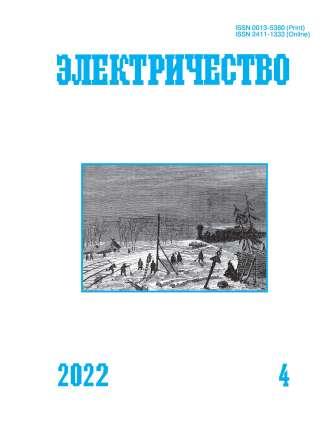Neural Network Based Calculation of Load Resistances Taking into Account the Multiport Input-to-Output Ratio Invariant Properties
Abstract
The invariant properties of a multiport input-output ratio as a model of unstable two- and three-wire power supply lines of power loads or resistive sensors are considered. The fractional linear expressions typical for the electrical circuit theory are interpreted as projective transformations in the sense of projective geometry. Projective transformations preserve an invariant: a cross ratio or a duplicate proportion of four samples of variable resistance and the corresponding values of currents in different sections of the circuit. In this way, it becomes possible to calculate the load resistances from the measured current samples at the circuit input and their known base or test values; in doing so, the circuit parameters are not explicitly used. In turn, the base load values can also vary or are known with some uncertainty. To eliminate the influence of the variable parameters, neural networks are used for the calculation. For training the neural network, a set of possible values of the base resistances, loads, and the variable resistance of the multiport itself is specified. The corresponding set of input currents forms a training vector, and the load values are components of the target vector. Numerical experiments carried out in the Deep Learning package of the MATLAB system with one and two loads show the control calculation accuracy for the trained shallow neural network at a level of one to two percent.
References
2. Bhattacharyya S.P., Keel L.H., Mohsenizadeh D.N. Linear Systems: A Measurement-Based Approach. Springer, India, 2014, 89 p.
3. Пенин А.А. Проективная геометрия в теории электрических цепей с переменными и нелинейными нагрузками: научный реф. дис. … доктора техн. наук. Кишинев, 2017, 81 с.
4. Penin A. Analysis of Electrical Circuits with Variable Load Regime Parameters: Projective Geometry Method. Springer International Publishing, Cham, Switzerland, 2020, 520 p., DOI:10.1007/978-3-030-35366-7.
5. Мазин В.Д. Способ повышения точности измерительных приборов и преобразователей. – Измерительная техника, 1980, № 6, с. 14–15.
6. Mazin V.D. Error of Measurement in the Compound-Ratio Method. – Measurement Techniques, 1983, vol. 26, No. 8, pp. 628–629, DOI: 10.1007/BF00833215.
7. Цыбульский О.А. Проективные свойства широкодиапазонных измерений. – Измерительная техника, 2013, № 1, с. 27–29.
8. Дьяконов В.П., Круглов В.В. MATLAB 6.5 SP1/7/7 SP1/7 SP2+ Simulink 5/6. Инструменты искусственного интеллекта и биоинформатики. М.: СОЛОН-ПРЕСС, 2009, 456 с.
9. Бураков М.В. Нейронные сети и нейроконтроллеры. СПб.: ГУАП, 2013, 284 с.
10. Вакуленко С.А., Жихарева А.А. Практический курс по нейронным сетям. СПб.: Университет ИТМО, 2018, 71 с.
11. Deep Learning Toolbox [Электрон. ресурс], URL: https://www.mathworks.com/help/deeplearning/ index.html (Дата обращения 20.02.2022).
12. Глаголев Н.А. Проективная геометрия. М.: Высшая школа, 1963, 343 с.
13. Ayres F. Schaum's Outline Series Theory and Problems of Projective Geometry. New York, McGraw–Hill, 1967, 249 p.
14. Riaza R. Circuit theory in Projective Space and Homogeneous Circuit Models. – IEEE Transactions on Circuits and Systems I: Regular Papers, 2019, vol. 66, No. 2, pp. 463–476.
15. Шолле Ф. Глубокое обучение на Python. СПб.: Питер, 2018, 400 с.
16. Новгородцев А.Б. Расчет электрических цепей в MATLAB. СПб.: Питер, 2004, 250 с.
17. Jin Z., Kaba, S. Deep Neural Network Based Behavioral Model of Nonlinear Circuits. – Journal of Applied Mathematics and Physics, 2021, No. 9, pp. 403–412.
#
1. Bessonov L.А. Teoreticheskiye osnovy elektrotekhniki. Elektricheskiye tsepi (Theoretical Foundations of Electrical Engineering. Electric Circuits). М.: Vysshaya shkola, 1996, 640 p.
2. Bhattacharyya S.P., Keel L.H., Mohsenizadeh D.N. Linear Systems: A Measurement-Based Approach. Springer, India, 2014, 89 p.
3. Penin А.А. Proektivnaya geometriya v teorii elektricheskih tsepey s peremennymi i nelineynymi nagruzkami: nauchnyy ref. dis. … doktora tekhn. nauk. (Projective Geometry in the Theory of Electric Circuits with Variable and Nonlinear Loads: Scientific Abstract of Dissertation of Dr. Sci. (Eng.)). Kishinev, 2017, 81 p.
4. Penin A. Analysis of Electrical Circuits with Variable Load Regime Parameters: Projective Geometry Method. Springer Internatio-nal Publishing, Cham, Switzerland, 2020, 520 p., DOI:10.1007/978-3-030-35366-7.
5. Mazin V.D. Izmeritel’naya tekhnika – in Russ. (Measurement Techniques), 1980, No. 6, pp. 14–15.
6. Mazin V.D. Error of Measurement in the Compound-Ratio Method. – Measurement Techniques, 1983, vol. 26, No. 8, pp. 628–629, DOI: 10.1007/BF00833215.
7. Tsybul’skiy O.A. Izmeritel’naya tekhnika – in Russ. (Measure-ment Techniques), 2013, No. 1, pp. 27–29.
8. D'yakonov V.P., Kruglov V.V. MATLAB 6.5 SP1/7/7 SP1/7 SP2+ Simulink 5/6. Instrumenty iskusstvennogo intellekta i bioinformatiki (MATLAB 6.5 SP1/7/7 SP1/7 SP2+ Simulink 5/6. Artificial Intelligence and Bioinformatics Tools). М.: SOLON-PRESS, 2009, 456 p.
9. Burakov M.V. Neyronnye seti i neirokontrollery (Neural Networks and Neurocontrollers). SPb.: GUAP, 2013, 284 p.
10. Vakulenko S.A, Zhikhareva A.A. Prakticheskiy kurs po neyronnym setyam (Practical Course on Neural Networks). SPb.: Universitet ITMO, 2018, 71 p.
11. Deep Learning Toolbox [Electron. resource], URL: https://www.mathworks.com/help/deeplearning/ index.html (Date of appeal 20.02.2022).
12. Glagolev N.A. Proyektivnaya geometriya (Projective geometry). M.: Vysshaya shkola, 1963, 343 p.
13. Ayres F. Schaum's Outline Series Theory and Problems of Projective Geometry. New York, McGraw–Hill, 1967, 249 p.
14. Riaza R. Circuit theory in Projective Space and Homogeneous Circuit Models. – IEEE Transactions on Circuits and Systems I: Regular Papers, 2019, vol. 66, No. 2, pp. 463–476.
15. Sholle F. Glubokoe obuchenie na Python (Deep Learning with Python). SPb.: Piter, 2018, 400 p.
16. Novgorodtsev A.B. Raschet elektricheskikh tsepey v MATLAB (Calculation of Electrical Circuits in MATLAB). SPb.: Piter, 2004, 250 p.
17. Jin Z., Kaba, S. Deep Neural Network Based Behavioral Model of Nonlinear Circuits. – Journal of Applied Mathematics and Physics, 2021, No. 9, pp. 403–412.




